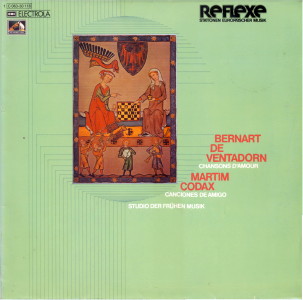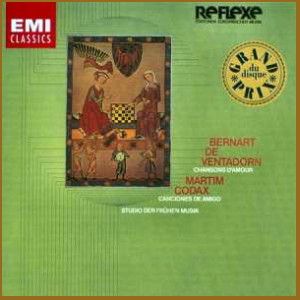 |
1 LP -
1C 063-30 118 - (p) 1973
|

|
| 1 CD - 8
26486 2 - (c) 2000 |
|
| Bernart
de Ventadorn - Martim Codax |
|
|
|
|
|
| MARTIM CODAX
(13. Jhdt.) |
|
|
| Siete canciones de
amigo - 2 Singstimmen,
Organetto, Laute, Fiedel, Flöte,
Schlagzeug |
|
|
| 1. Ondas do mar
de vigo |
3' 11" |
|
| 2. Mandad ei
comigo ca ven meu amigo |
3' 16" |
|
| 3. Mia ýrmana
fremosa treidos comigo |
2' 30" |
|
| 4. Aý deus se
sab ora meu amigo |
5' 20" |
|
| 5.
Quantas sabedas amae amigo |
2' 00" |
|
| 6.
Eno sagrado en vigo |
4' 27" |
|
| 7.
Y ondas que eu vin veero |
2' 45" |
|
|
|
|
| Bernart
de Ventadorn (12. Jhdt.) |
|
|
Chansons d'amour
|
|
|
| - Ab joi mou le
vers e.I momens - 2
Singstimmen, Organetto,
Psalterium, Chitarra
sarazenica, Rebec, Lira,
Schlagzeug |
14' 02" |
|
| - Poi preyatz
me, snhor - 2 Singstimmen,
Laute, Lira |
12' 00" |
|
|
|
|
STUDIO DER FRÜHEN
MUSIK / Thomas Binkley, Leitung
|
|
| -
Andrea von Ramm, Sängerin |
|
| -
Richard Levitt, Sänger |
|
| -
Sterling Jones, Streichinstrumente |
|
| -
Thomas Binkley, Zupfinsrumente |
|
|
|
|
|
Luogo
e data di registrazione |
|
Bürgerbräu.
München (Germania) - maggio 1973 |
|
|
Registrazione: live /
studio |
|
studio |
|
|
Producer / Engineer |
|
Gerd
Berg / Johann Nikolaus Matthies
|
|
|
Prima Edizione LP |
|
EMI
Electrola "Reflexe" - 1C 063-30
118 - (1 lp) - durata 49' 31" -
(p) 1973 - Analogico |
|
|
Prima Edizione CD |
|
EMI
"Classics" - 8 26486 2 - (1 cd) -
durata 49' 31" - (c) 2000 - ADD |
|
|
Note |
|
- |
|
|
|
|
|
THE
TECHNIQUE OF
PLAYING MONOPHONIC MUSIC
The question
of performance style warrants
some comment, because it is
this more than anything else
that enables the musician
today to come to grips with
very early music, and it is an
understanding of this that
enables the listener to enter
critically into this world of
art.
We are accustomed to expect
the musical score to reflect
fairly precisely the sound of
a performance; even allowing
for a bit of improvisation
here and there, we expect the
general flow of the music to
be what is notated in the
score. This is essentially
true of Western music from
about 1300 on, beginning with
polyphonic music. It is
not true of monophonic music.
The secular song of the
Troubadours and the Juglares
and many others was
expressed on paper
only in terms of the text and
the melody, while its
expression in sound
was quite something else. Each
region, or at least many
regions, developed performance
styles of their own, which
means that the same song was
performed differently in
different places or under
different circumstances.
The singing style is one thing
that changed from place to
place, the sort of
improvisation is another, and
the choice of accompanying
instruments another. Even the
very idea behind the
performance, whether a
spontaneous performance or a
carefully arranged show for
invited guests, had a
significant influence on the
resultant sound.
What we have here is the sort
of thing the professional
musicians at a wealthy court
in southern France and in
northern Spain made of this
material. The instrumental
prelude tries to attract
attention to the performance,
establishes the tonality and
general aesthetic level of the
song. The strophes are
separated by interludes which
serve as a diversion. The
accompaniments are in
different styles, now in
dialogue with the singer, now
providing an accoustical
background, now
moving with the singer along
the same line. The guiding
factor in the instrumental
work is the playing technique
of the instruments involved.
Each instrumentalist tries to
bring the essence of his
instrument into play, to be
sure, within the bounds of a
chosen style but without
subordinating the
chracteristics of the
instrument to contrapuntal
ideology.
MARTIM
CODAX
Martim Codax,
the early 13th century
Galician juglar has
left us in his Siete
Canciones de Amigo, his
Seven Songs of Love the
earliest surviving examples of
Iberian secular Music.
We know very littly about the
man, nor do we completely
understand how he came to
write these songs as a cycle
(no other song cycles are
known from this period).
The setting is the town of
Vigo, located on the Atlantic
coast of Spain just above the
Portuguese border, and well
known today for its excellent
cuisine of fish and mollosks.
In the
13th century, one came to Vigo
by way of two routes: one was
the Camino de Santiago, the
Pilgrim Road, called the
Camino Francés,
because it led from France
across the whole of the North
of Spain (viz. El Camino
de Santiago 1C O63-30
107 and 1C 063-30 108). The
other route to Vigo was the
Sea.
Today, ships come from far and
wide, loading and unloading
goods, bringing and taking
away travellers; today, the ondas
do mar, the waves of the
sea drifting towards an
industrial town no longer
suggest a poetic image, no
longer contain a mystery of
completely unknown qualities.
But in the 13th century no
ships came from around the
world to dock at Vigo, because
then the world was flat, and
the sea surrounded the only
piece of land there was, and
the sea led
out to a great nothingness beyond,
a darkness and emptiness
feared by
all men.
For Martim Codax the sea at
Vigo was the end of the world,
and it was never certain that
who sailied away from that
shore would not fall off the
edge of the world never to
return. That then is the
emptiness of this lover who
waits by
the church on the hill
overlooking the sea at Vigo,
waiting for his (or her)
belovod, not understanding why
she (he) does not come.
BERNART
DE VENTADORN
Bernart de
Ventadorn was a troubadour,
which we hasten to point out
was not really a profession
but an activity which was a
part of and which reflected a
particular life style.
Those familiar with France
will know the Limousin, but
few will know the town of
Egletons, which is the closest
rail connection to the ruins
of the once very impressive
castle of Ventadorn.
Enviable were those
inhabitants of the Languedoc
in the 12th century, for life
then was cosy in the South of
France. The art of the
troubadours flourished in the
warm sun and gendered a
particular cultural ambiance
in the courts of the nobility,
where love of beauty, of
music, of poetry and women
were central to the creative
and recreative life.
We think of the Count of
Poitiers, Peire Vidal, of
Bertrand de Born, P. de
Auvergne, G. de Bornelh, etc.
etc. but of the many
troubadours and the thousands
of poems and songs they have
left us, Bernart de Ventadorn
and his five-dozen songs are
classic.
Only in one attribute is
Bernart not typical of his
colleagues: he was of low
birth, son of an archer and
the woman who fired the
bake-ovens at the castle of
Ventadorn. Yet Bernart came to
be accepted into the house of
his benefactor, the viscount
of Ventadorn, who himself was
a singer and poet and may have
been Bernart’s teacher. The
viscount had an attractive
wife who - according to the
vida - was the cause of some
considerable difficulty for
herself and for Bernart, but
there is not a shread of
evidence to support that
contention. It is true, to be
sure, that Bernart left his
comfortable Ventadorn
involuntarily, and, practiced
in the art of courtly love and
courtly poetry, soon found a
place at the court of Eleanore
of Acquitaine, reina dels
Normans, wife (at that
time) to Henry II of
England.
Bernart spent some time in
Normandy and then went with
the queen to England where he
stayed at least for two years.
There it was where he wrote Pois
preyatz me, senhor... to
his distant Asziman, the
otherwise nameless object of
his earlier attentions.
Needless to say, Asziman was
not the sole object of Bernart’s
attentions, but an early and
revered one. Bels-Vezers was
another (Ab joi meu...),
who some contend was the wife
of the Count of Vienne and
others say was the wife of
Raimon V, Count of Toulouse
whose name was Constance. What
does it matter who she was.
Bernart disguised the names of
his loves effectively,
even employing the masculine
gender on occasion. Bernart de
Ventadorn began to write
poetry about 1140 and he died
before 1194. All of his poems
are love poems of a personal
nature, of which the two
selected here are quite
typical.
Thomas
Binkley
|
|
|
EMI Electrola
"Reflexe"
|
|
|
|

